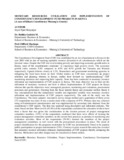Monetary Resources Utilization and Implementation of Constituency Development Fund Projects in Kenya
Abstract
The Constituency Development Fund (CDF) was established by an Act of parliament in Kenya in the year 2003 with an aim of ensuring equitable resource allocation to all constituencies which are the electoral zones. Despite the CDF role in alleviating poverty and improving economic growth index in Kenya, most of the constituencies continues’ to experience high poverty levels. The economic growth index remains 5.6% compared to 6.9% and 6.5% growth for Tanzania and Rwanda respectively. Uganda follows closely at 5.2%. Researchers and government monitoring agencies in mitigating the trend have borne no fruit. Global studies on CDF have concentrated on project selection and planning whereas in Kenya, studies have focused on “professionalizing” CDF monitoring structures and improving their capacity. None has been conducted in monetary resource utilization and implementation of CDF projects in Kenya. The main objective was to find out the utilization of monetary resources and how it affects implementation of CDF projects in Kenya whereas the specific objectives were; managerial practices, monitoring and evaluation, procurement processes and governance. Drawing from the fiscal interest theory and economic welfare theory it was conceptualized that the independent variable and dependent variable were monetary resource utilization and implementation of CDF projects respectively. The unit of the study was the Constituency. The study adopted descriptive survey design method and a population of thirty seven (37) respondents was used. It was a census study with a response of 87%. Primary data was collected using self-administered questionnaires and was supplemented by secondary data obtained from the constituency’s CDF reports. The data was analyzed using descriptive and inferential statistics. The study found out that: Most (n=14) (43.8%) of the respondents considered the education levels to have been a factor that was given fair consideration in the election process of project management committee members. (53%) of the respondents confirmed that there were efforts of training the project management committee members on the current best practices as pertains to monitoring and evaluation activities. Most of the respondents (59.4%) deemed the members of the project management committees as well versed with the procurement procedures in place. The mode of project identification for the programs undertaken by CDF was predominantly found to be popular public participation in project determination (53%). Contrary to prior research this study has revealed that monetary resource utilization enhances implementation of CDF projects thereby advancing the theories. Moderators and other designs may be considered in future studies.
Collections
- Journal Articles (BE) [351]

